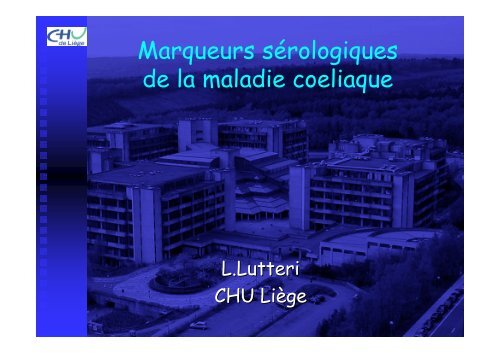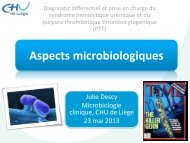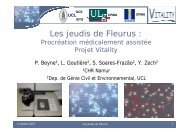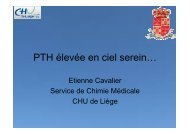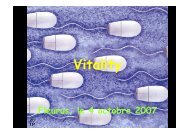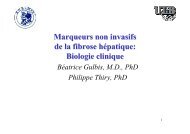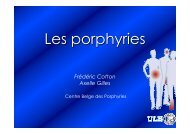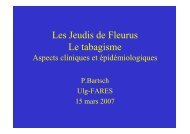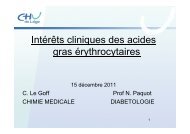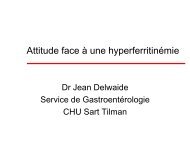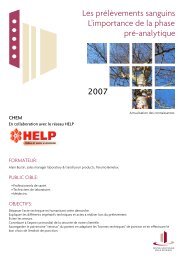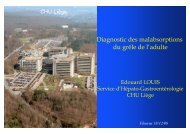Marqueurs sérologiques de la maladie coeliaque - Les Jeudis de ...
Marqueurs sérologiques de la maladie coeliaque - Les Jeudis de ...
Marqueurs sérologiques de la maladie coeliaque - Les Jeudis de ...
You also want an ePaper? Increase the reach of your titles
YUMPU automatically turns print PDFs into web optimized ePapers that Google loves.
<strong>Marqueurs</strong> <strong>sérologiques</strong><br />
<strong>de</strong> <strong>la</strong> ma<strong>la</strong>die <strong>coeliaque</strong><br />
L.Lutteri<br />
CHU Liège
Anti-réticuline (1970)<br />
IFI sur rein,foie,estomac <strong>de</strong> rat, R1 (et Rs), IgA<br />
estomac<br />
rein<br />
Musc.mucosae + , fibrilles entre fluo. péritubu<strong>la</strong>ire<br />
cell. épithéliales.<br />
fluo. périgloméru<strong>la</strong>ire<br />
+ foie : vaisseaux + , fluo. linéaire autour sinusoï<strong>de</strong>s<br />
<strong>Jeudis</strong> <strong>de</strong> Fleurus 18.12.08
Anti-réticuline R1 IgA<br />
Sensibilité : 40-60 %<br />
Spécificit<br />
cificité : +/- 100 %<br />
<strong>Jeudis</strong> <strong>de</strong> Fleurus 18.12.08
Anti-endomysium (1983, Chorzelski)<br />
Réagissent avec <strong>la</strong> substance intermyofibril<strong>la</strong>ire<br />
du muscle lisse.<br />
IFI :<br />
<br />
œsophage <strong>de</strong> singe<br />
Fluorescence en nid d’abeille<br />
<strong>de</strong> <strong>la</strong> muscu<strong>la</strong>ris mucosae du<br />
tiers inférieur <strong>de</strong> l’œsophage<br />
<strong>de</strong> singe (partie contenant le<br />
plus d’antigène « endomysium »)<br />
<strong>Jeudis</strong> <strong>de</strong> Fleurus 18.12.08
Anti-endomysium<br />
IFI :<br />
<br />
cordon ombilical humain (fluorescence <strong>de</strong> type rayon<br />
<strong>de</strong> miel <strong>de</strong>s couches muscu<strong>la</strong>ires <strong>de</strong>s veines du cordon)<br />
A. Ocmant Erasme.<br />
<strong>Jeudis</strong> <strong>de</strong> Fleurus 18.12.08
Anti-endomysium<br />
Recherche <strong>de</strong>s IgG uniquement en cas <strong>de</strong><br />
déficit en IgA.<br />
Sensibilité : > 90 %<br />
Spécificit<br />
cificité : > 99 %<br />
Surveil<strong>la</strong>nce régime r<br />
sans gluten : ↓ après<br />
3 à 12 mois <strong>de</strong> régime r<br />
sans gluten.<br />
Cible antigénique nique principale :<br />
transglutaminase tissu<strong>la</strong>ire.<br />
<strong>Jeudis</strong> <strong>de</strong> Fleurus 18.12.08
Anti-transglutaminase (1997 : Dieterich)<br />
Auto-anticorps<br />
⇒ ma<strong>la</strong>die auto-immune.<br />
1ère générationg<br />
: TG <strong>de</strong> foie <strong>de</strong> cobaye<br />
2ème générationg<br />
: TG tissu<strong>la</strong>ire humaine<br />
recombinante ou purifiée e (TG 2) .<br />
<strong>Jeudis</strong> <strong>de</strong> Fleurus 18.12.08
Anti-transglutaminase<br />
Anti-Endo<br />
Anti-gptTG<br />
Anti-htTG<br />
CD<br />
24/24<br />
24/24<br />
24/24<br />
Controls<br />
0/183<br />
15/183<br />
6/183<br />
Sensitivity<br />
100 %<br />
100 %<br />
100 %<br />
Specificity<br />
100 %<br />
92 %<br />
97 %<br />
Crohn, colites,<br />
mal. auto-immunes,…<br />
Carroccio. Clinical Chemistry 48:9; 1546-1550 1550 (2002)<br />
<strong>Jeudis</strong> <strong>de</strong> Fleurus 18.12.08
<strong>Jeudis</strong> <strong>de</strong> Fleurus 18.12.08
Anti-transglutaminase<br />
<br />
faux positifs ⇒ anti-endomysium :<br />
reconnu comme le test le plus spécifique :<br />
à faire comme test <strong>de</strong> confirmation d’un d<br />
anti-tTG tTG + avant <strong>de</strong> faire biopsies.<br />
Anti-tTG tTG : + sensible<br />
Anti-endomysium : + spécifique<br />
<strong>Jeudis</strong> <strong>de</strong> Fleurus 18.12.08
Anti-transglutaminase<br />
TG <strong>de</strong> GR humains :<br />
BIOCARD CELIAC DISEASE Test.<br />
<strong>Jeudis</strong> <strong>de</strong> Fleurus 18.12.08
Anti-gliadines<br />
Contre <strong>la</strong> fraction alcoolo-soluble du<br />
gluten → α-gliadine<br />
Métho<strong>de</strong> <strong>de</strong> détectiond<br />
:<br />
IFI : rein <strong>de</strong> rat + gliadine (se fixe sur fibres<br />
<strong>de</strong> réticuline) r<br />
(Interférence rence <strong>de</strong>s antiréticuline<br />
!)<br />
ELISA (pas <strong>de</strong> standard : en unités<br />
arbitraires) ou dot (pas quantitatif !)<br />
<strong>Jeudis</strong> <strong>de</strong> Fleurus 18.12.08
Anti-gliadines<br />
Sensibilité IgA : 65-100 %<br />
IgG : 68-91 %<br />
Spécificit<br />
cificité IgA : 50-95 %<br />
IgG : 42-95 %<br />
⇒ Sensibilité et<br />
spécificité basses<br />
retrouvés s dans PR, néphropathies<br />
n<br />
à IgA, ma<strong>la</strong>dies<br />
chroniques du foie ou autres ma<strong>la</strong>dies inf<strong>la</strong>mmatoires <strong>de</strong><br />
l’intestin.<br />
→ utilisés s uniquement pour suivi du régime r<br />
sans<br />
gluten (et chez jeunes enfants)<br />
<strong>Jeudis</strong> <strong>de</strong> Fleurus 18.12.08
+ IL-15<br />
<strong>Jeudis</strong> <strong>de</strong> Fleurus 18.12.08
<strong>Jeudis</strong> <strong>de</strong> Fleurus 18.12.08
Antigenic epitopes of gliadin<br />
Disease controls<br />
CD patients<br />
<strong>Jeudis</strong> <strong>de</strong> Fleurus 18.12.08<br />
From EUROIMMUN
<strong>Jeudis</strong> <strong>de</strong> Fleurus 18.12.08
Anti-Gliadin (GAF-3X) ELISA<br />
Gliadin-Analogous<br />
nalogous Fusion pepti<strong>de</strong> (GAF),<br />
containing 3 repetitive sequences.<br />
PLQPEQPFP<br />
PEQLPQFEE<br />
Gliadin analogous pepti<strong>de</strong>s<br />
GAF (Gliadin analogous fusion pepti<strong>de</strong>)<br />
GAF-3X<br />
<strong>Jeudis</strong> <strong>de</strong> Fleurus 18.12.08
Study<br />
137 samples from biopsy-proven<br />
proven CD<br />
patients.<br />
115 biopsy-proven<br />
proven disease controls.<br />
626 samples from patients with<br />
col<strong>la</strong>genosis.<br />
400 samples from healthy blood<br />
donors.<br />
<strong>Jeudis</strong> <strong>de</strong> Fleurus 18.12.08
Sensitivity – Specificity<br />
137 biopsy-proven CD patients and 115 biopsy-proven disease controls<br />
ELISA<br />
Sensitivity<br />
Specificity<br />
Anti-Gliadin IgA<br />
68.6 %<br />
90.7 %<br />
Anti-Gliadin IgG<br />
Anti-Gliadin IgA<br />
(GAF-3X)<br />
Anti-Gliadin IgG<br />
(GAF-3X)<br />
Anti-tTG tTG (IgA)<br />
91.2 %<br />
83.2 %<br />
85.4 %<br />
97.8 %<br />
78.7 %<br />
96 %<br />
98.7 %<br />
96 %<br />
Anti-tTG tTG (IgG)<br />
32.1 %<br />
100 %<br />
<strong>Jeudis</strong> <strong>de</strong> Fleurus 18.12.08
Specificity<br />
626 patients with col<strong>la</strong>genosis<br />
Samples<br />
n<br />
AGA A<br />
AGA G<br />
GAF A<br />
GAF G<br />
TTG A<br />
TTG G<br />
RA<br />
200<br />
15.5%<br />
9.5%<br />
3%<br />
0.5%<br />
0.5%<br />
0%<br />
SS<br />
200<br />
14.5%<br />
5.5%<br />
4.5%<br />
2%<br />
1.5%<br />
0%<br />
SLE<br />
100<br />
23%<br />
21%<br />
3%<br />
7%<br />
0%<br />
0%<br />
PSS<br />
126<br />
14.3%<br />
4%<br />
4.8%<br />
2.4%<br />
3.2%<br />
0.8%<br />
SPECIFICITY<br />
626<br />
83.9%<br />
91.1%<br />
96.2%<br />
97.6%<br />
98.7%<br />
99.8%<br />
<strong>Jeudis</strong> <strong>de</strong> Fleurus 18.12.08
Specificity<br />
626 patients with col<strong>la</strong>genosis<br />
Samples<br />
n<br />
AGA A<br />
AGA G<br />
GAF A<br />
GAF G<br />
TTG A<br />
TTG G<br />
RA<br />
200<br />
15.5%<br />
9.5%<br />
3%<br />
0.5%<br />
0.5%<br />
0%<br />
SS<br />
200<br />
14.5%<br />
5.5%<br />
4.5%<br />
2%<br />
1.5%<br />
0%<br />
SLE<br />
100<br />
23%<br />
21%<br />
3%<br />
7%<br />
0%<br />
0%<br />
PSS<br />
126<br />
14.3%<br />
4%<br />
4.8%<br />
2.4%<br />
3.2%<br />
0.8%<br />
SPECIFICITY<br />
626<br />
83.9%<br />
91.1%<br />
96.2%<br />
97.6%<br />
98.7%<br />
99.8%<br />
<strong>Jeudis</strong> <strong>de</strong> Fleurus 18.12.08
Specificity<br />
400 healthy blood donors<br />
Samples<br />
n<br />
AGA A<br />
AGA G<br />
AGA II A<br />
AGA II G<br />
Blood Donors<br />
400<br />
3.3 %<br />
22 %<br />
2.3 %<br />
2.0 %<br />
<strong>Jeudis</strong> <strong>de</strong> Fleurus 18.12.08
Sensitivity<br />
AGA A<br />
AGA G<br />
GAF 3X A<br />
GAF 3X G<br />
tTG A<br />
tTG G<br />
Sensitivity<br />
at a specificity of 95 %<br />
56 %<br />
31 %<br />
83 %<br />
94 %<br />
96 %<br />
63 %<br />
<strong>Jeudis</strong> <strong>de</strong> Fleurus 18.12.08
Sensitivity<br />
AGA A<br />
AGA G<br />
GAF 3X A<br />
GAF 3X G<br />
tTG A<br />
tTG G<br />
Sensitivity<br />
at a specificity of 95 %<br />
56 %<br />
31 %<br />
83 %<br />
94 %<br />
96 %<br />
63 %<br />
<strong>Jeudis</strong> <strong>de</strong> Fleurus 18.12.08
Etu<strong>de</strong> au CHU <strong>de</strong> Liège<br />
Gliadines Natives Gliadines Gliadines Natives Gliadines Déamidées Gliadines Déamidées Gliadines Déamidées<br />
Binding Site Natives Chorus Biorad<br />
Euroimmun Binding Site<br />
Inova<br />
UI/ml AU/ml U/ml U/ml U/ml<br />
U/ml<br />
neg
Comparaison faux positifs<br />
Euroimmun/Binding Site (/Inova)<br />
Faux positifs<br />
Gliadines Déamidées<br />
Euroimmun<br />
UI/ml<br />
neg
<strong>Jeudis</strong> <strong>de</strong> Fleurus 18.12.08
Sévérité <strong>de</strong> <strong>la</strong> pathologie<br />
D’après poster Inova (GL Norman)<br />
<strong>Jeudis</strong> <strong>de</strong> Fleurus 18.12.08
Dermatite herpétiforme<br />
<br />
<br />
Intolérance au gluten mais à expression<br />
essentiellement cutanée.<br />
Souvent associée à <strong>la</strong><br />
ma<strong>la</strong>die <strong>coeliaque</strong>.<br />
Sérums <strong>de</strong> patients DH réagissent r<br />
avec une forte<br />
avidité avec TG3 (transglutaminase épi<strong>de</strong>rmique) et<br />
TG2.<br />
n = 18<br />
tTG IgA<br />
AGA II IgA<br />
AGA II IgG<br />
Sensitivity<br />
72 %<br />
78 %<br />
78 %<br />
<strong>Jeudis</strong> <strong>de</strong> Fleurus 18.12.08
Déficit en IgA<br />
IgA endomysium, tTG, Gliadines<br />
IgG gliadine : peu spécifique et peu sensible.<br />
IgG endomysium : spécifique mais IFI…<br />
IgG tTG (rHu) : ….<br />
<strong>Jeudis</strong> <strong>de</strong> Fleurus 18.12.08
Déficit en IgA : anti-tTG IgG<br />
tTG + gliadines<br />
Sensibilité …???<br />
Spécificité !!!<br />
Sensibilité<br />
Spécificité<br />
<strong>Jeudis</strong> <strong>de</strong> Fleurus 18.12.08
Déficit en IgA<br />
Sensibilité<br />
Spécificit<br />
cificité<br />
IgG<br />
AGA<br />
IgG<br />
DGP<br />
40 %<br />
80 %<br />
87 %<br />
98 %<br />
<strong>Jeudis</strong> <strong>de</strong> Fleurus 18.12.08
Déficit en IgA<br />
Patient<br />
1<br />
2<br />
3<br />
4<br />
5<br />
Anti-tTG<br />
tTG<br />
Neg<br />
Pos<br />
Pos<br />
Pos<br />
Pos<br />
IgG<br />
AGA II<br />
Pos<br />
Pos<br />
Pos<br />
Pos<br />
Pos<br />
<strong>Jeudis</strong> <strong>de</strong> Fleurus 18.12.08
Enfants <strong>de</strong> moins <strong>de</strong> 2 ans<br />
tTG<br />
Sensibilité < 2 ans<br />
Sensibilité<br />
Tonutti, 2003<br />
Foie <strong>de</strong> cobaye<br />
87,8 %<br />
96,7 % (2-14 ans)<br />
Fabiani, 2001<br />
Foie <strong>de</strong> cobaye<br />
69 %<br />
91,5 % (tous)<br />
Agardh, 2003<br />
Recom. humaine<br />
63,1 %<br />
93,7 % (2-15 ans)<br />
<strong>Jeudis</strong> <strong>de</strong> Fleurus 18.12.08
Enfants <strong>de</strong> moins <strong>de</strong> 2 ans<br />
AC anti-gliadine présents avant AC<br />
anti-endomysium/ anti-tTG.<br />
tTG.<br />
↓<br />
mauvaise spécificit<br />
cificité<br />
↓<br />
gliadines déamidd<br />
amidées.<br />
<strong>Jeudis</strong> <strong>de</strong> Fleurus 18.12.08
Régime sans gluten<br />
Tous les AC disparaissent +/- vite sous<br />
régime sans gluten et réapparaissent r<br />
lors<br />
<strong>de</strong> <strong>la</strong> réintroduction r<br />
<strong>de</strong> gluten.<br />
Anti-gliadines natives<br />
Sous régime r<br />
sans gluten, IgA disparaissent; ils<br />
réapparaissent moins <strong>de</strong> 48 heures après<br />
réintroduction du gluten dans l’alimentation.<br />
l<br />
IgG peuvent parfois persister plus longtemps.<br />
<strong>Jeudis</strong> <strong>de</strong> Fleurus 18.12.08
Régime sans gluten<br />
<strong>Les</strong> anticorps anti-gliadines déamidd<br />
amidées IgA<br />
augmentent et diminuent plus rapi<strong>de</strong>ment<br />
que les anti-tTG. tTG. Ils sont donc meilleurs<br />
pour le suivi du régime r<br />
sans gluten.<br />
Chute <strong>la</strong> plus significative<br />
après 3 mois <strong>de</strong> régime sans gluten.<br />
<strong>Jeudis</strong> <strong>de</strong> Fleurus 18.12.08<br />
Agardh, 2007
Régime sans gluten<br />
<strong>Jeudis</strong> <strong>de</strong> Fleurus 18.12.08
<strong>Jeudis</strong> <strong>de</strong> Fleurus 18.12.08
<strong>Jeudis</strong> <strong>de</strong> Fleurus 18.12.08
Anti- « transglutaminase »<br />
Néo-épitope : tTG + gliadine<br />
Sensibilité : 82.9 %<br />
Spécificité : 92.3 %<br />
Aeskulisa Celicheck New Generation IgA + IgG<br />
Reeves<br />
Eur J Gastroenterol Hepatol<br />
2006<br />
<strong>Jeudis</strong> <strong>de</strong> Fleurus 18.12.08
Etu<strong>de</strong> avec le kit <strong>de</strong> Biorad<br />
<br />
<br />
<br />
<br />
MC, tTG néoépitope n<br />
+ : n = 4<br />
tTG IgA +, Endo IgA +, DGP IgA et IgG +<br />
MC, tTG néoépitope<br />
n<br />
- : n = 2<br />
tTG IgA +, Endo IgA +, DGP IgG +, DGP IgA –<br />
tTG IgA +, Endo IgA +, DGP IgG et IgA –<br />
DH, tTG néoépitope n<br />
+ : n =1<br />
<br />
tTG IgA -, DGP IgA +, DGP IgG -<br />
Pas MC, tTG néoépitope n<br />
+ : Faux positifs<br />
<br />
<br />
N = 1 : tTG IgA -,, DGP IgA et IgG – : RCUH<br />
N = 3 : tTG IgA -, DGP IgA et/ou IgG + : Biopsies -<br />
<strong>Jeudis</strong> <strong>de</strong> Fleurus 18.12.08
Screening tTG/DGP IgA et IgG INOVA<br />
DGP IgA -, DGP IgG -, TTG IgA - : n = 4<br />
Faux positifs<br />
DGP IgA +, DGP IgG -, TTG IgA - : n = 2<br />
Screening<br />
positif<br />
DGP IgA -, DGP IgG +, TTG IgA - : n = 9<br />
DGP IgA -, DGP IgG -, TTG IgA + : n = 1<br />
DGP IgA +, DGP IgG +, TTG IgA - : n = 3<br />
DGP IgA -, DGP IgG +, TTG IgA + : n = 3<br />
DGP IgA +, DGP IgG +, TTG IgA +: n = 4<br />
<strong>Jeudis</strong> <strong>de</strong> Fleurus 18.12.08
<strong>Jeudis</strong> <strong>de</strong> Fleurus 18.12.08<br />
Plus d’intérêt en cas<br />
<strong>de</strong> déficit en IgA<br />
qu’anti-tTG IgG !!
OU<br />
DGP IgG / tTG IgA<br />
Combinaison <strong>la</strong> plus<br />
intéressante d’autant<br />
plus car détection <strong>de</strong>s<br />
déficits en IgA !<br />
ET<br />
<strong>Jeudis</strong> <strong>de</strong> Fleurus 18.12.08
Anti-Actine IgA<br />
4ème colloque du GEAI<br />
-Corré<strong>la</strong>tion avec titre d’AC et sévérité <strong>de</strong> l’atrophie : atrophie totale : toujours +<br />
atrophie partielle : rare<br />
-Disparition sous régime sans gluten.<br />
<strong>Jeudis</strong> <strong>de</strong> Fleurus 18.12.08
Algorithme pour le diagnostic <strong>de</strong> <strong>la</strong><br />
ma<strong>la</strong>die <strong>coeliaque</strong><br />
<strong>Jeudis</strong> <strong>de</strong> Fleurus 18.12.08
<strong>Jeudis</strong> <strong>de</strong> Fleurus 18.12.08
<strong>Marqueurs</strong> <strong>sérologiques</strong><br />
<strong>de</strong>s MICI
Serological Diagnostic Tests<br />
Antibodies against Saccharomyces<br />
cerevisae : ASCA<br />
ANCA<br />
Antibodies against exocrine pancreas.<br />
Antibodies anti-glycan<br />
glycan.<br />
Antibodies against microbial epitopes.<br />
<strong>Jeudis</strong> <strong>de</strong> Fleurus 18.12.08
ASCA<br />
Against carbohydrate epitopes in<br />
phosphopeptidomannan, a glycoprotein<br />
of the cell wall of the yeast<br />
Saccharomyces cerevisae.<br />
Antibodies or autoantibodies ?<br />
<strong>Jeudis</strong> <strong>de</strong> Fleurus 18.12.08
ASCA : Prevalence<br />
Crohn’s s disease : 40-60 %<br />
Ulcerative colitis : 5-155<br />
%<br />
Healthy blood donors : 0-50<br />
5 %<br />
AIH, coeliac disease,…<br />
ASCA : PPV<br />
Crohn’s s disease : 54-92 %<br />
<strong>Jeudis</strong> <strong>de</strong> Fleurus 18.12.08
N = 139,<br />
CD= 37, UC = 37, inf<strong>la</strong>mmatory diseases = 35, healthy subjects = 30<br />
<strong>Jeudis</strong> <strong>de</strong> Fleurus 18.12.08
ASCA<br />
Standard method :<br />
Indirect Immunofluorescence.<br />
IgA : 1/100<br />
IgG : 1/1000<br />
<strong>Jeudis</strong> <strong>de</strong> Fleurus 18.12.08
ASCA by IF in CD<br />
Sensitivity<br />
Specificity<br />
PPV<br />
ASCA IgA<br />
81 %<br />
93 %<br />
84 %<br />
ASCA IgG<br />
54 %<br />
100 %<br />
84 %<br />
ASCA IgA or<br />
IgG<br />
81 %<br />
92 %<br />
77 %<br />
ASCA IgA and<br />
IgG<br />
54 %<br />
100%<br />
94 %<br />
<strong>Jeudis</strong> <strong>de</strong> Fleurus 18.12.08
ASCA ELISA :<br />
Inova, Euroimmun, Aesku.<strong>la</strong>b, Medipan.<br />
Sensitivity<br />
Specificity<br />
PPV<br />
ASCA IgA<br />
41-59 %<br />
92-95 95 %<br />
88-89%<br />
89%<br />
ASCA IgG<br />
41-75 %<br />
88-96 %<br />
85-91 %<br />
ASCA IgA or<br />
IgG<br />
51-83 %<br />
84-93 %<br />
83-88 88 %<br />
ASCA IgA and<br />
IgG<br />
30-53 %<br />
97-98 98 %<br />
94-95 95 %<br />
<strong>Jeudis</strong> <strong>de</strong> Fleurus 18.12.08<br />
Klebl. Int. J. Colorectal. Dis. 2004.
ASCA ELISA :<br />
Inova, Euroimmun, Aesku.<strong>la</strong>b, Medipan<br />
IgA or IgG.<br />
100<br />
90<br />
80<br />
70<br />
60<br />
50<br />
40<br />
30<br />
20<br />
10<br />
0<br />
Inova Euroimmun Aesku.<strong>la</strong>b Medipan<br />
Sensitivity<br />
Specificity<br />
PPV<br />
<strong>Jeudis</strong> <strong>de</strong> Fleurus 18.12.08<br />
Klebl. Int. J. Colorectal. Dis. 2004.
ASCA : Dots<br />
n=24 : 18 CD, 2 UC, 2 IC, 2 HP.<br />
IgA or IgG<br />
IF<br />
DOTS<br />
ELISA<br />
Sensitivity<br />
72 %<br />
33 %<br />
44 - 94 %<br />
Specificity<br />
67 %<br />
100 %<br />
67 %<br />
<strong>Jeudis</strong> <strong>de</strong> Fleurus 18.12.08
ASCA<br />
ASCA (presence or high titer) IgA and/or<br />
IgG have been linked with<br />
more severe disease course (high rate of<br />
complications)<br />
small bowel involvement (with or without<br />
colonic disease) : more typical than pure<br />
colonic disease.<br />
earlier onset of disease<br />
ASCA IgA + in children : higher risk for<br />
re<strong>la</strong>pses.<br />
<strong>Jeudis</strong> <strong>de</strong> Fleurus 18.12.08<br />
.
ASCA<br />
Presence of ASCA is stable over time,<br />
does not change with drug treatment or<br />
surgical removal of the affected colon.<br />
No corre<strong>la</strong>tion between titre and disease<br />
activity, duration and behaviour or medical<br />
treatment.<br />
Vasiliauskas. Gastroenterology 1996;<br />
Vermeire. IBD 2001;<br />
Koutroubakis. Am J Gastoenterol 2001.<br />
<strong>Jeudis</strong> <strong>de</strong> Fleurus 18.12.08
Predictive maker<br />
ASCA may predict <strong>de</strong>velopment of IBD<br />
years before the disease is clinically<br />
diagnosed.<br />
ASCA were <strong>de</strong>tected in 31 % of patients<br />
before the clinical diagnosis of CD.<br />
Israeli. Gut. 2005<br />
<strong>Jeudis</strong> <strong>de</strong> Fleurus 18.12.08
59 % of coeliac patients had IgA and/or IgG<br />
ASCA.<br />
After gluten-free diet, 93% lost IgA ASCA<br />
whereas 83% maintained IgG ASCA reactivity.<br />
<strong>Jeudis</strong> <strong>de</strong> Fleurus 18.12.08
ANCA<br />
Anti-Neutrophil Cytop<strong>la</strong>smic Antibodies<br />
Diagnostic of different types of<br />
vasculiti<strong>de</strong>s.<br />
Standard method :<br />
Indirect Immunofluorescence :<br />
Ethanol-fixed leucocytes sli<strong>de</strong>s<br />
<strong>Jeudis</strong> <strong>de</strong> Fleurus 18.12.08
ANCA<br />
cANCA<br />
pANCA<br />
Granu<strong>la</strong>r cytop<strong>la</strong>smic fluorescence<br />
accentuated between the nuclear lobes<br />
Fine homogeneous rim-like staining of the<br />
perinuclear cytop<strong>la</strong>sm.<br />
<strong>Jeudis</strong> <strong>de</strong> Fleurus 18.12.08
ANCA<br />
Neutrophiles fixés à<br />
l'ETHANOL<br />
BPI<br />
cANCA pANCA nucléaire<br />
anti-PR3<br />
Neutrophiles fixés à <strong>la</strong><br />
FORMALINE<br />
Cellules Hep 2<br />
Granulomatose<br />
<strong>de</strong> Wegener<br />
négatif<br />
Neutrophiles fixés au METHANOL<br />
cANCA<br />
anti-MPO<br />
-<br />
négatif<br />
pANCA<br />
positif<br />
négatif<br />
ANCA atypique :<br />
- polyarthrite rhumatoï<strong>de</strong><br />
- ma<strong>la</strong>dies hépatiques<br />
Rectocolite<br />
ulcérohémorragique<br />
-polyangéite microscopique<br />
- syndrome <strong>de</strong> Churg-Strauss<br />
- glomérulonéphrite nécrosante<br />
- périartérite noueuse nécrosante<br />
ELASTASE<br />
CATHEPSINE G<br />
LACTOFERRINE<br />
LYSOZYME<br />
<strong>Jeudis</strong> <strong>de</strong> Fleurus 18.12.08
Target antigen : ?<br />
xANCA or NANA<br />
(nuclear associated neutrophil antibodies) :<br />
Ag con<strong>de</strong>nsed on the inner si<strong>de</strong> of the<br />
nuclear membrane of the neutrophil.<br />
<strong>Jeudis</strong> <strong>de</strong> Fleurus 18.12.08
pANCA : Prevalence<br />
Ulcerative colitis : 40-85 %<br />
Crohn : 4-254<br />
%<br />
pANCA : PPV<br />
Ulcerative colitis : 70 %<br />
<strong>Jeudis</strong> <strong>de</strong> Fleurus 18.12.08
pANCA +<br />
Ulcerative colitis :<br />
more resistant to treatment<br />
more aggressive disease<br />
requiring surgery early<br />
Crohn ≡ subgroup<br />
« ulcerative colitis-like<br />
like » phenotype:<br />
left-si<strong>de</strong>d colitis, generally good therapeutical<br />
response, uncomplicated disease course, <strong>la</strong>ter<br />
age of onset.<br />
<strong>Jeudis</strong> <strong>de</strong> Fleurus 18.12.08
pANCA<br />
No corre<strong>la</strong>tion between ANCA titres<br />
and disease activity ( >< vasculiti<strong>de</strong>s)<br />
Roozendaal. QJM, 1999<br />
ANCA titer remains unchanged after<br />
colectomy. Reumaux. IBD 2000<br />
<strong>Jeudis</strong> <strong>de</strong> Fleurus 18.12.08
ASCA / ANCA<br />
%<br />
UC<br />
CD<br />
Sens<br />
Spe<br />
Sens<br />
Spe<br />
PPV<br />
pANCA<br />
55,3<br />
88,5<br />
ASCA<br />
53,3<br />
89,2<br />
pANCA +<br />
ASCA -<br />
pANCA -<br />
ASCA +<br />
51,3<br />
94,3<br />
55<br />
93<br />
75-<br />
93<br />
77-<br />
96<br />
<strong>Jeudis</strong> <strong>de</strong> Fleurus 18.12.08<br />
Reese. Am J Gas, 2006
<strong>Jeudis</strong> <strong>de</strong> Fleurus 18.12.08
<strong>Jeudis</strong> <strong>de</strong> Fleurus 18.12.08
<strong>Jeudis</strong> <strong>de</strong> Fleurus 18.12.08<br />
Joossens.<br />
Gastroenterology. 2002
Anti- exocrine pancreas<br />
Prevalence :<br />
Crohn : 31 %<br />
Ulcerative colitis : 2 %<br />
IFI on primate pancreas, IgA and IgG, 1/10<br />
Ag ?<br />
No corre<strong>la</strong>tion between titre and disease<br />
activity, duration and behaviour or medical<br />
treatment or extra-intestinal<br />
manifestations.<br />
Distinct CD subgroup ?<br />
<strong>Jeudis</strong> <strong>de</strong> Fleurus 18.12.08
AB against microbial epitopes.<br />
Anti-OmpC<br />
:<br />
<br />
antibodies against the outer-membrane porin C protein of<br />
Escherichia coli<br />
IgA: 38-55 % of CD, , 2-112<br />
% of UC, 2-5% 2<br />
non-IBD subjects<br />
I<strong>de</strong>ntification of 5-15% 5<br />
of ASCA – CD patients.<br />
<br />
More aggressive course of disease and higher risk for<br />
surgical interventions.<br />
<strong>Jeudis</strong> <strong>de</strong> Fleurus 18.12.08
AB against microbial epitopes.<br />
Anti-I2<br />
:<br />
<br />
<br />
<br />
antibodies against a Pseudomonas fluorescens-associated<br />
structure<br />
IgA : 54% of CD, , 10 % of UC, 19% other enteric<br />
inf<strong>la</strong>mmatory diseases, 5% healthy subjects.<br />
Increased risk for complications in adult CD patients.<br />
Anti-CBir<br />
:<br />
<br />
<br />
<br />
antibodies against the CBir1 f<strong>la</strong>gellin (gram-)<br />
52 % of CD, , 6% of UC, 14% of other inf<strong>la</strong>mmatory<br />
intestinal diseases, 8% control subjects.<br />
Associated with ileal involvement in adult CD patients<br />
<strong>Jeudis</strong> <strong>de</strong> Fleurus 18.12.08
Anti-glycan antibodies<br />
Anti-<strong>la</strong>minaribiosi<strong>de</strong> carbohydrate AB (ALCA)<br />
Anti-chitobiosi<strong>de</strong> carbohydrate AB (ACCA)<br />
<br />
Anti-mannobiosi<strong>de</strong> carbohydrate AB (AMCA)<br />
Sensibility : 38% (ALCA), 36 % (ACCA), 28% (AMCA)<br />
Specificity : 90 %, at least 2 AB : 99 %<br />
44 % of ASCA - CD : anti-glycan +<br />
In CD, higher levels of AB (ALCA) associated<br />
with small intestine disease.<br />
<strong>Jeudis</strong> <strong>de</strong> Fleurus 18.12.08<br />
Dotan. Gastroenterology. 2006
ASCA / pANCA<br />
Lack of standardization → <strong>la</strong>rge<br />
inter<strong>la</strong>boratory variation.<br />
I<strong>de</strong>ntification of antigens (ANCA)<br />
Harmonization of ASCA assays :<br />
Cut-offs<br />
Ag<br />
<strong>Jeudis</strong> <strong>de</strong> Fleurus 18.12.08


